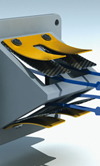Poppet Valve Materials
 Last month, we looked at the application of hollow valves, and noted, as had Anne Proffit’s recent article, that titanium is a popular choice for these components. Many engineers who specify hollow valves do so for reasons of mass reduction and improved valve control; hence titanium is a natural choice in this respect.
Last month, we looked at the application of hollow valves, and noted, as had Anne Proffit’s recent article, that titanium is a popular choice for these components. Many engineers who specify hollow valves do so for reasons of mass reduction and improved valve control; hence titanium is a natural choice in this respect.
Titanium has very low density compared to the more traditional poppet-valve materials and so is the kind of material that we look to when trying to minimise mass as part of a valvetrain optimisation exercise.
However, as I once explained to someone full of excitement at the prospect of turning some valves from Ti-6Al-4V on the lathe, it isn’t as simple as using any old piece of titanium. The titanium alloys used for racing poppet valves are carefully selected for their properties, and have specific heat-treatments applied for their specific application. They need to have the correct level of fatigue strength at operating temperature (not just room temperature!) and this is where we begin to depart from the common titanium alloys.
A common titanium valve alloy, which many of the manufacturers use, is Ti-6242, which is more highly alloyed than Ti-6Al-4V, and contains the same 6% of aluminium, along with 2% of tin, 4% of zirconium and 2% of molybdenum. There may optionally be small additions of other elements to this alloy.
The heat-treatment of the material, which is a solution treatment followed by aging, is different depending on the final application. Inlet valves and exhaust valves are treated differently according to their operating environment. The inlet valve is much better cooled than an exhaust valve, having a blast of relatively cool air/fuel mixture passing over it (in the case of a carburetted or port injected gasoline engine) each engine cycle, where an exhaust has to withstand the discharge of high temperature combustion products. Possibly, where scavenging is poor, the exhaust valve also has to withstand some cool gas passing over it, increasing the temperature range over which it has to operate. The exhaust valve material is generally treated to a lower level of strength than the inlet material.
It is possible to combine two pieces of the same titanium valve material, but having differing mechanical properties, arrived at by thermal means, or by different work-hardening processes in the same finished component. This is often done by the process of friction welding, where one component is held stationary whilst the other part to be welded is rotated at high speed and then brought into contact with the stationary part. Heat quickly builds, melting the two surfaces and providing a strong welded joint which is perfectly able to withstand the rigours of use as a poppet valve. This type of welding, which is used widely in industry, provided excellent quality across the whole joint face.
The welding, of course, takes place before final machining, and on visual inspection of a valve thus produced, there is no sign of there being two parts welded together.
The accompanying picture shows a friction welding process for an industrial application, and although it is not a racing valve, the process is very similar in principle.
So, we can see that, in addition to its low density and strength, titanium lends itself to manufacturing processes which mean that its properties can be tailored precisely to its intended application.
Written by Wayne Ward.